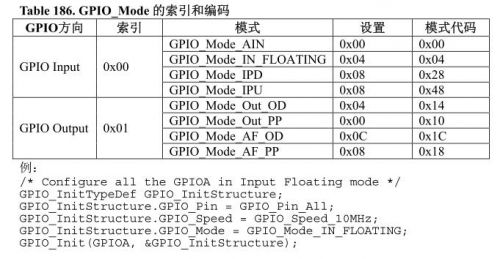|
 
- UID
- 1062083
- 性别
- 男
|

STM32的IO口能够由软件配置成8种模式,如图所示。好出在于在硬件设计的时候,可以方便I/0的选择,从而走线上带来方便。
模拟输入
输入模式 浮空输入
输入下拉
输入上拉
输出模式 开漏输出
推挽输出
复用开漏输出
复用推挽输出

我们今天使用的按键端口,配置为上拉输出,这样的话,按键未按下时值为1,当按键按下时值为0。LED使用的I/O配置为推挽输出模式,用于指示按键的状态。我们专门把按键模块写成子文件,方便下次功能的移植。程序只是简单的叙述了数字输入的检测功能,实际应用中按键还应加延时消抖处理。程序采用轮询查询的方法,实际上使用中断的方法,更加有效。
KEY.C代码:
#include "key.h"
void KEY_Configuration(void)
{
GPIO_InitTypeDef GPIO_InitStructure;
RCC_APB2PeriphClockCmd(RCC_APB2Periph_GPIOA|RCC_APB2Periph_GPIOB|RCC_APB2Periph_GPIOC, ENABLE);
GPIO_InitStructure.GPIO_Pin = KEY1 | KEY3;
GPIO_InitStructure.GPIO_Speed = GPIO_Speed_50MHz;
GPIO_InitStructure.GPIO_Mode = GPIO_Mode_IPU;
GPIO_Init(GPIOC, &GPIO_InitStructure);
//GPIO_InitStructure.GPIO_Speed = GPIO_Speed_50MHz;//可以省略,下面都是按照上面相同的配置
//GPIO_InitStructure.GPIO_Mode = GPIO_Mode_IPU;
GPIO_InitStructure.GPIO_Pin = KEY2;
GPIO_Init(GPIOB, &GPIO_InitStructure);
//GPIO_InitStructure.GPIO_Speed = GPIO_Speed_50MHz;
//GPIO_InitStructure.GPIO_Mode = GPIO_Mode_IPU;
GPIO_InitStructure.GPIO_Pin = KEY4;
GPIO_Init(GPIOA, &GPIO_InitStructure);
}
KEY.H代码
#ifndef __KEY_H
#define __KEY_H
#include "stm32f10x_conf.h"
#define KEY1 GPIO_Pin_4
#define KEY2 GPIO_Pin_10
#define KEY3 GPIO_Pin_13
#define KEY4 GPIO_Pin_0
#define Read_key1() ((GPIOC->IDR & KEY1)?0:1)//按下时才为0
#define Read_key2() ((GPIOB->IDR & KEY2)?0:1)
#define Read_key3() ((GPIOC->IDR & KEY3)?0:1)
#define Read_key4() ((GPIOA->IDR & KEY4)?0:1)
//#define Read_key1() !GPIO_ReadInputDataBit(GPIOC, KEY1)
//#define Read_key2() !GPIO_ReadInputDataBit(GPIOB, KEY2)
//#define Read_key3() !GPIO_ReadInputDataBit(GPIOC, KEY3)
//#define Read_key4() !GPIO_ReadInputDataBit(GPIOA, KEY4)
void KEY_Configuration(void);
#endif |
|